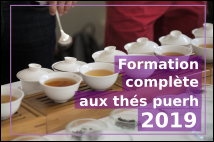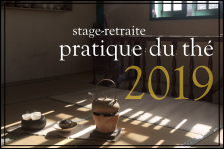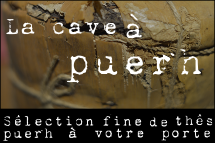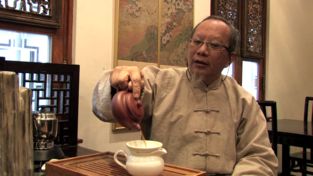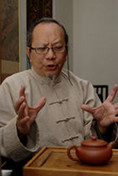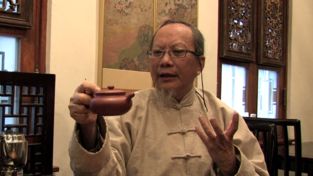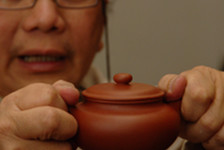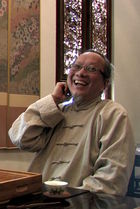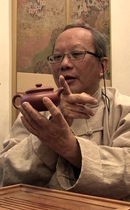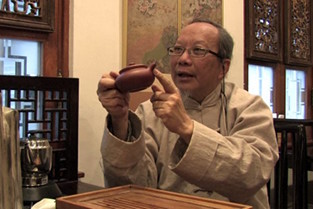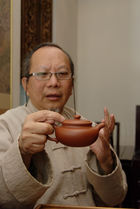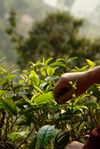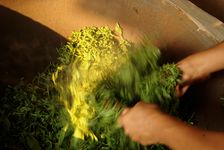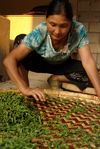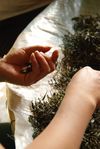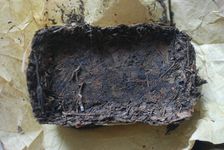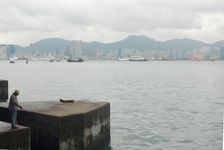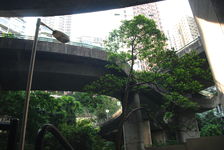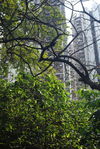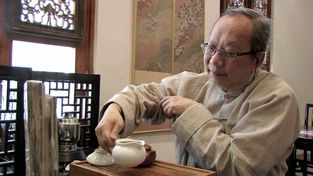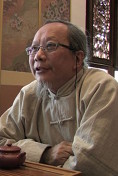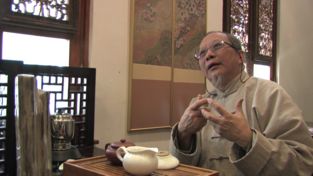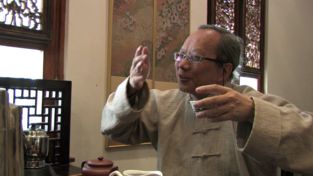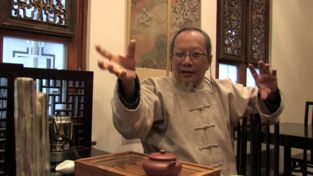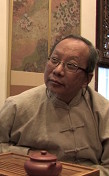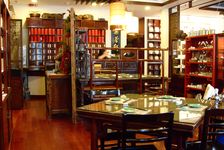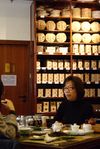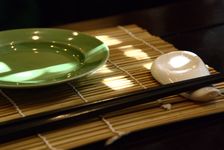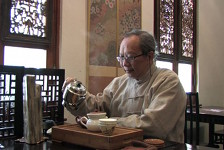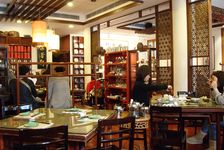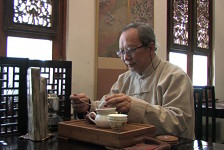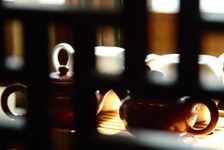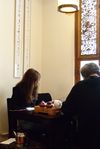 This page is not a real translation but just an automatic translation generated by computer of the original article, written in French language! Its not good... but better than nothing!
This page is not a real translation but just an automatic translation generated by computer of the original article, written in French language! Its not good... but better than nothing!Want to help us do diffuse puerh tea culture in english, by providing a better (or corrected) translation?
Please contact us!

Wing-Chi Ip is undoubtedly one of the great names in tea culture. Artist, university professor, founder of the famous Lock Cha Tea House in Hong Kong, Wing-Chi Ip is one of the largest Chinese tea experts, but also Yixing teapots he collects from his childhood and he has contributed to the development and diffusion since the 80s.
It all started when Wing-Chi was still at school. Amateur nascent tea and tea, Wing-Chi is a day intrigued a street corner by a Yixing teapot he meets in a window. Nobody cared in Yixing time and Wing Chi buys this teapot for only pennies. This will be the first part of a long series and for years Wichg Chi meticulously buy for a pittance, each rare Yixing teapots that could then find in Hong Kong.
At the end of the school Wing-Chi enters a university to study Chinese culture and art, where he developed a particular interest in calligraphy and Chinese philosophy, inseparable for him to tea culture. After graduation, Wing-Chi became a professor and researcher in the department of the university ceramics.
He will meet KS Lo, specialist and famous collector teapot Hong Kong, then put on a program of research on Zi Sha and Yixing pottery and the result in this adventure. So Wing-Chi and KS Lo went for the first time in 1978 in Yixing, a few years before the uncontrollable phenomenon Yixing they would give birth around this land, Hong Kong, and soon around the world .
But next to the world of tea, which he bathes in over 30 years, Wing-Chi has a particular passion for tea, including the puerh, but also tea houses, which has gradually its means of expression. After an initial small tea shop that Chi Wing opened in 1991 at Sha Tin in the New Territories of Hong Kong, plans to materialize teahouse opening in 2003 Lock Cha Tea House at the prestigious Museum of teaware Hong Kong.
More than just a tea house, Lock Cha Tea House is a mirror that reflects the personality and vision of the Chi-Wing Tea IP creation unceasingly renewed mingling with natural happiness and tea, art and culture.
I had the chance to share a nice moment with Wing-Chi Cha Lock in 2010 to perform for you this long interview, where Wing-Chi discusses with passion why the phenomenon Yixing tea culture of Hong Kong, its Mink and of course his puerh (Pu Er tea) tea house and the special relationship he has with it.
A big thank you to Wing Chi Ip for his time and passion.
Teapots the beginnings of Yixing Zi Sha and
I do not know (laughs). In fact I think it is the destiny you know, nobody can say what will be your future. Of course as I am a Chinese from Hong Kong, I drink tea for a long time. My father was a doctor of traditional medicine, so I drank a lot of tea when I was young and ... I did not. Liquor was so dark ... in fact it was tea puerh, because Chinese medicine sees the puerh (Pu Er tea) as something good, "neutral" and rich body. You know, while watching Chinese term Ying and Yang and puerh (Pu Er tea) for its part, more neutral, and helps you keep a good balance. But I did not like tea, I just knew it was good. I was more interested at that time by the Yam Cha and Dim Sum, Hong teahouses Kongaise.
Then I was trained to be an artist, I'm a calligrapher, painter traditional Chinese painting. Then I met this gentleman, Mr. KS Lo, founder of the museum (The KS Lo Gallery) at the university. Then this is how I changed my career to pottery. We went to Yixing with Mr. KS Lo, and found that the Yixing pottery was particularly interesting, and so we started all trade in pottery.
And environ10 years later, this pottery has become very famous. Now I can say that I am the cause of this, the great masters of Yixing pottery. This is something that I created, because at that time it was the Yixing pottery and that was all. We do not know the name of Yixing, they had no name known among potters, or real personalities artist. That is why we tried to promote these potters and their work, and it was a great success.
And after the policy change of Deng Xiao Ping about Hong Kong, many Taiwanese came to China (mainland) and have completely ruined the market. Then I found that the market in Taiwan was not so good, and I thought rather to continue my business in Hong Kong. But I told myself that if I sold that teapot ... I feel really alone ... without tea. So I decided to sell tea as it was in 1988 or something like that.
Aini is that I changed my hobby into a business, but at the time I worked for a well-known company in the sale of Yixing and my partner did not agree, he was not interested in tea. So in 1991 I left the company and I started a shop, Lock Cha, and began selling tea.
I just started collecting teapots in my youth. Then I looked into the thing and I did some research on the subject. Then I went to Yixing teapots to see how they were made. Then this is how I changed careers and I became salesman teapots. So from 1980 to .... until now we can almost say I've seen and sold a lot of tea, but I promotes and I have made them famous. There are collectors who have become very very expensive now, at this time it may be worth 50 cents, 10 cents for a teapot.
Yes I did the first exhibition of Yixing in Hong Kong in 1981, the festival in Asia. That was really the starting point of Yixing. Then we made a beautiful catalog, Yixing and quickly became very popular. Since 1981 there has been a lot of exhibitions around Yixing.
No no, it was not so different. The real difference is just the system and how things were in Yixing. Because the master potters have always been there, the technique has always been there.
In fact before 1957 or 1958 there was really a lot of workshops in Yixing. After 1958 they (government. NDRL) were all together to create large factories, and they put all the potters and teachers in the same factories to make them work. Under these conditions, and the Cultural Revolution, the masters had no motivation.
At this time all these potteries went in state enterprises import and export. They just had a catalog with a few products in it, very little. When there was an order from Hong Kong for example, they were just taking a teapot that was in stock this form and send it to be sold.
There were very few models. But I was a bit strange, I was still in school but I was very impressed with the teapots. So I gradually bought all different teapots that we could find. It only cost me 50 cents, or 5 HKD sometimes. Each time a new form was available, I bought it. And then I can be like that 30 or 40 different teapots. It was not so crazy, and then it was very common everyday objects.
Then I went to Yixing, in factories, and I saw their showroom, it was crazy! Waaaa so beautiful teapots! Then inevitably you ask them:why you do not sell? And then the employees of the plant you only respond:because nobody buys them.
But Why? Because the state-owned import-export (which manages and controls production. NDRL) controls only models of their catalog, what is in this catalog that has not changed for a long time. Then he made at the factory and re-did the same models continuously.
Then of course you ask them if you can buy these models you see in the showroom? But this is impossible, because they had no right to sell tea directly, it was necessary for it to go to Nanjing (in the State Department. NDRL) to discuss.
At that time I was traveling with Mr. KS Lo was an important man in Hong Kong and on the way back to Shanghai, he said:Oh what a shame, maybe we could buy some tea there ( Yixing) and sell in Hong Kong, it may be a good thing. So we canceled the flight back to Hong Kong and returned to Nanjing to discuss the organization of import-export. And these people in Nanjing were very nervous, they directly called Yixing people to various appointments in this regard.
We did not know at that time, but then we realized, and there have been a series of appointments to discuss the possibility of a special order for Mr. KS Lo. Because Mr. KS Lo was Zhengxie Daibiao , an important man of politics. So it was a very special order and very expensive too.
I remember at that time three specific requests for this order:Number one, the teapot should be made by a teacher or by a single potter, not a collaboration type is someone's body, someone made the cover or something like that. Not everything must start to end is made by the same man. Second, the piece was to be signed. Third, the name of the potter should be engraved on the bottom of the pot.
In fact we just tried to remember the tradition. Las during Ming and Qing Dynasties, it was in this way that the teapots were made. It was a more personal, more artistic, more like a work of art:do one thing from beginning to end, not by dividing the work in factories like state. So we started like that.
Then it took another two years before the teapots arrive in Hong Kong. Teapots arrived in 1981. We had control in 1979! Because they did not care at that time, it was ... standards Communists. So finally we got the tea and started to do promotion, etc..
Finally something really different is that we changed the system in which these teapots were part of something that was just an everyday object we did something more artistic. Before that all standards were teapots with "Yixing China," and the cover y'avait he just wrote a reference, eg 51. That was changed to the name of the artist, then did burn in the teapot, to try to give more dimension to the artistic thing.
And then I wrote a book about artist potters, which is released with exhibitions etc.. For some it was a real boom, everyone looked teapots of these masters. Now there are so many master potters. But it all started in 1981 with something simple, sign the room and make a name as a master potter.
No no no, this is not true. Mine No. 4 was closed. Yes that's true. It was the largest mine, but it was one of the mines. They built mines to tap deep into the soil, because the soil is deep and Zi Sha spreads in horizontal layer, and between these layers there are other things. So they must drill deeper to find the good earth. And therefore mine 4 has become so deep that they had to close it because it became too dangerous. But there are other mines.
Something else has also changed since the 90s:the market has become private. So what are private companies that do business and as everyone in China they seek to explore all the ways to make money, and they have large reserves of Zi Sha. So many people just speculated on the ground and in Yixing have stored large quantities, so now we have a huge reserve of this earth, it is far from being exhausted.
But of course there are different qualities of clay, maybe the best there is less and less now. After that, there is no false clay pots, clay is always true, manufacture of clay is very difficult. But when it comes to false, for example we want to improve color, you want a redder color, so we add other materials in the ground, perhaps clay elsewhere, sometimes chemistry . Because pure clay quality is too expensive, many resort to other things to improve the quality, or to obtain a better color, and mix different things together.
Or they have new technology to spray something on the ground, and send it as chemistry, for example, and of course ... they are not very good tea. After I do not think that it is always more dangerous for health or bad. Because in history we have already done this kind of thing is not new. In the Qing Dynasty they were already mixed colors, they made tea green, black where they mixed land they rajoutaient different things in the earth. There was also painted red teapots, one might think that the earth was naturally like that but no, it was painted. All this has been done, it is not a new phenomenon.
But maybe now it's done in a less careful, they use cheaper materials can be toxic. It's like cooking, before cooking it using the best ingredients, and then was used MSG (a flavor enhancer used daily in China), and now using the chemical agents of flavor and texture, poisons. This is terrible ...
In fact in history things have always evolved, technology, etc., many things change over time. But the difference is that now things are changing too fast and very stupid. That's the real problem. I do not mind that we change things using more land, mixing land, etc., it is something very natural. During the Song Dynasty they were already doing this, because the clay premium was too expensive, so they were the teapot with a land cheaper, then they put the land more expensive on the surface. I think we can see a form of technique.
But at the time people were more reasonable, taking into account health, etc.. Now there are people using all sorts of chemicals, do not take into consideration that the price money. They do not care about the rest, and that is the real problem.
Waw (laughs)! This is not a stupid question, but it is a big question. It would take a long time to respond, but I think Amblee two things:firstly, a teapot is a utilitarian object, so I think the function of the object is very important, it must be functional.
Then a good pot should form a good combination or have a good relationship with the tea. Eg for puerh (Pu Er tea) you need a larger pot for the oolong tea a finer, something like that.
Secondly it is a more aesthetic. You need a very good material, cooked at the right temperature, but when you look at the teapot you feel it is done in the right proportions, feel that there's a spirit in it. It is very important to me. Perhaps because I studied art, I am very sensitive to proportions. With some teapots proportion is not correct ... I can not accept that.
The nose in particular is a very important part. Most people can easily make the body, but only a master can do a perfect spout. It's very hard. And beak in Chinese it is the eye of the dragon, this is a crucial part. I think at first glance a teapot, my eyes will be on the bill.
It happened to me sometimes yes. I'm not a potter, and Yixing pottery is very specific, just to prepare the land it requires a lot of study and practice. So I can not do it alone, but by cons I know how to use a teapot, what type is best suited for a particular tea, things like that. So I can give advice to potters, tell them how to make a teapot more convenient to use. Sometimes I draw the shape for something specific, things like that. But I can not really make my own tea.
From culture to Hong Kongaise aged puerh, originally maturing market ...
Yes traditional doctor, because we do not inject, we do not take pills, etc.. Usually we write just a prescription of different herbs. Then with this you go to the pharmacy and then you boil these plants in a kettle for brewing and beverage you drink.
Tea is a very good remedy for the flu. But Hong Kong tea (puerh) was most commonly used in families to help digestion, balance, and this was primarily a drink. We drink tea every day here, especially during the holidays because during the holidays I eat lots of food, lots of oil and therefore we need tea to help and improve digestion. So the tea is not just a drug.
Of course we must also know that the Chinese follow a very strange approach to medicine that is particularly difficult to explain. And they say that green tea will "refresh" the body (in the sense of opposing torques Heating-Cooling or Yin-Yang which is based on any traditional Chinese medicine. NDRL), while black tea (red tea in Chinese ) will instead "warm up" the body. The puerh (Pu Er tea) for its part is more neutral, and helps balance the body.
I think it is the idea of tea that I inherited from my father. But tea is not specifically a medicine, it's just something good and beneficial for the body.
Mmmmm .... okay. I do not know exactly. Because Hong Kongers look tea in a very very special. Tea consumption has a long history in Hong Kong. Somehow, as in all of southern China, the people attending the tea houses, spent time there. The Lou Cha (tea houses) were a kind of social place where we ate Dim Sum, we talked, we met his friends, it was the business. There was not much attention to the cultivation of tea. Of course it is already a culture, but it did not it too seriously, as something to consider. I think that is the main thing to understand about Hong Kong.
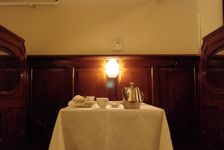
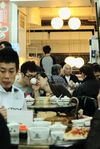
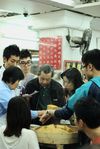
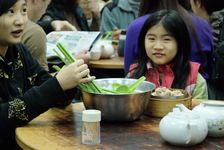
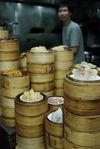
- 1.One of the oldest traditional teahouse (Dim Sum Yam Cha) Hong Kong
- 2.Tea House (Dim Sum Yam Cha) Hong Kong People
- 5.Tea House (Dim Sum Yam Cha) popular in Hong Kong
Of course, the tea is increasingly bad now, people pay more attention to the quality of tea, but they are even more attention to the food now! Because ... there are many many reasons, people pay more attention to many things. They simply continue to love this kind of atmosphere in the morning they go to teahouses for breakfast, afternoon people also go to tea houses, and in the evening they go to tea houses for dinner.
In the past this was not the same in the past it was a ... different function. And it was not the same kind of restaurant. Now rents are very expensive, the owners want to do business 24 hours on 24, teahouses are open non-stop and then there is also all kinds of things. In the past with the morning tea you would not have had such a dinner, or something like that.
This is the main thing that has not changed, Hong Kong people drink tea everyday, just as something very common and not take so seriously.
And then there were some changes in the 80s, before 1980 because as I said all tea came from the corporate state import-export (CNNP), so even if you wanted to have a very special tea You could not find it. But in the 80's some people like me have been able to enter the tea market, which was not necessarily under the control of a centralized system and the state.
It is also a time when the cultivation of tea, and activities around the tea became more popular. This is first time to Taiwan. Firstly because Taiwan has had years of prosperous economy, people in Taiwan brought more attention to tea. But also because in the 80 Taiwan was seeking the roots of their culture. So the 80s were a real boom in the development of tea culture.
And China also had a good response, because at that time it was all politics, and what we were looking forward while China was the unit. So many Chinese cultural activities were, in various ways, supported by the government. And therefore in this period we have seen the opening of modern tea shops, there were around during tea, some people learned to Taiwan and opened classes of tea. This is when I open a tea shop, I served tea free in my shop, so you could taste the tea before buying it, it was very popular at that time and people were really enthusiastic.
Yes yes yes. It was a very modern approach, a more serious approach, compared to Yam Cha, and traditional tea houses. It was in the late 80s and early 90s.
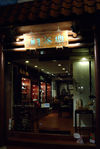
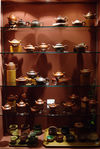
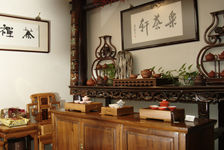
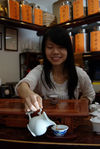
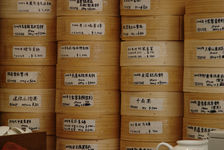
- 1.Lock Cha Tea Shop in Hong Kong in 2010
- 4.Lock Cha Tea Shop in Hong Kong 2010
- 5.Lock Cha Tea Shop in Hong Kong in 2010
Then, of course Hong Kong was a particular situation. A Hong Kong people have learned that Hong Kong would return to China. So we felt the need to learn something about China and Chinese culture. But of course the Chinese philosophy it is very difficult, poetry is also very difficult, art is difficult ... it was the easiest tea (laughs). So many people at that time wanted to learn about tea, it was a way to understand China! So it was quite prosperous at that time, at that time people drank more tea than coffee.
And after 1997, China has gradually opened, and Hong Kong lacked the strength to grow. So in the early 2000s things were quieter, but it was a good time for business, because a lot of stores in Hong Kong had the (old) puerh. And as the Chinese puerh (Pu Er tea) liked they were sold puerh, and it made big bucks. There are a number who really made his fortune in Hong Kong with that, yes.
It has been good for business, but the tea culture has really lost something exciting after opening.
Yeah, this is one of the reasons why I made this business. In the 1980s there was a new policy, especially after 1986 or something like that, we had the right to go to China and visit the villages. And so I got someone on my team, because his family had a farm of Fujian tea, and the first tea farm I visited in Fujian that was his home.
It was very interesting that the quality was completely different from what we could find on the market. Because in these times, all passed by an undertaking of national import-export (CNNP), they mixed all the tea leaves in grade 1, grade 2, grade 3, grade 4, etc .... Then they had agents, and it was these agents who sell tea. And in general there were quotas for higher grades. If you had a good relationship with the agent, or if you buy a lot, so he could sell you a few grade 1.
But I had no way to access these teas. Because at that time I had a small shop, so I bought just tea for my friends and some acquaintances. So when I went to my friend's house, it was amazing, each tea was a character! It was very different from what it could have on the market, the teas were not mixed. So I bought some tea, then I wrote some articles on it and I sold it as "single origin tea" or tea from a "single batch".
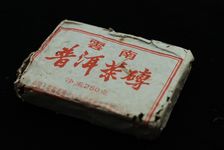
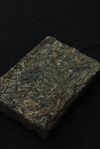
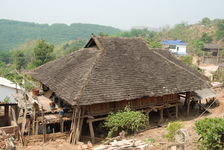
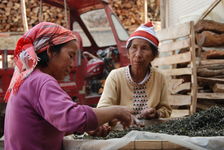
- 1.brick puerh (Pu Er tea) sold by CNNP in the 80
- 2.brick puerh (Pu Er tea) sold by CNNP in the 80s
- 3.Farm in Xishuangbanna (Jinuo Shan)
It was very interesting. Of course it was not as perfect as the tea market for these teas because they balance everything there (by assembling the sheets. NDRL.), They balance the taste, shape, color. But I teas may not be so perfect, but very special, unique. The taste was wonderful, and then you could feel some ... differences between teas.
Of course this is my mind:I hate uniformity. Everyone the same, it's terrible! At that time when you were in China, everyone was dressed in gray or green, it was very strange. I went for the first time in China in 1971. I felt with my friend that we were surrounded by hundreds of people who looked at us like animals! "Oh red! "... they were surprised by the colorful clothes that they wore, because at that time all the clothes were gray or green.
So I was very impressed with the tea I found among the peasants, because it was different. I can say that y'avait more in mind. Then I started the tea trade, it was in 1987.
In some ways you could buy tea. You need some form of certificates, then sent the tea in Guangdong, some companies had these certificates, and they were asked to export the tea in Hong Kong. It took a lot of tricks to make it ...
At this point I just wanted some very special teas, just for fun, it was very interesting.
So I tasted lots of tea and found it was a lot of land to develop ... Then after that I did a lot of traveling throughout China. Already because China has become increasingly open, and then felt more safe to travel through China, to stay in the homes of peasants, etc..
I think in the early 90s I really come across Chinese tea ... and what has impressed me is to realize that you can not understand the tea before seeing how it is produced. This is very important. Otherwise it becomes like product in a supermarket, you can not perceive its value, perceive that it is very special.
But when you look at the origin of tea, you understand all the patience, all the delicacy of farmers who take care of this tea, the way the leaves are harvested at just the right time and the right way. And then the tea can take its true value, otherwise ... this is a piece of paper, not so interesting. So I better understood after traveling tea. I have not had a teacher or something like that, I know that tea I learned peasants.
Of course I never become a "master," I'm not a "master" now, I just love tea, I traveled, and I learned a lot of farmers. So this is how I understand the tea.
Then assembled on the tea I can not denigrate the assembly because the assembly is also an art form. But people flock tea for many reasons.
First for commercial reasons, they just want to maintain a standard. Lipton sells tons of tea every year, so they must maintain a taste, you Twining, you English breakfast, you have many different assemblies that have a certain taste that perpetuates it. So we can assemble it.
Second reason we assemble tea for economic reasons. Some teas too old that we can not sell ... they are assembled with tea fresher, and it sells. But also assembles for balance, taste, aroma, etc. ....
So I can not completely denigrate the assembly. If you assemble a very good way, it's an art form, but I prefer to drink tea unassembled. As I said this is perhaps not as perfect, but it has a special character. And if you want to assemble, and although you can do it yourself, it's fun, I can not remove yourself pleasure!
So far I'm still single origin teas. I think the assembly is something good, but if you buy different teas single origin, you can assemble yourself. You buy some tea here, some tea there, and then you make your assembly. I think the tea lovers can. So I let people do this, I try as much as possible to keep the tea as a single batch.
Of course for some teas you can not, because they are already assembled at the source, such as Jasmine, you can not have a single batch of jasmine, because it is already assembled from the beginning. Or as green tea, it is already assembled, because green tea is simple and depends on the grade, grade 1, grade 2, etc ... So have some teas assembly needs.
After as we talk about puerh, now people like puerh (Pu Er tea) unassembled. But before 2000, all Chinese teas were assembled, as Menghai Tea Factory, they all assembled. So he names the tea, 8582 or some things like that. This is a tea to be assembled, but it is very interesting because it actually has no meaning:
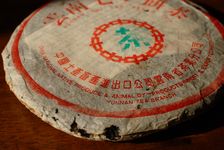
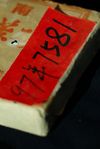
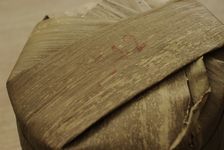
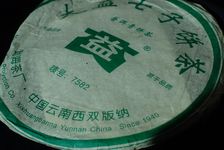
- 1.years Galette 7542 90
- 2.7581 Reference added by a collector on a brick 90s
- 3.Reference 7542 registered a tong Menghai Tea Factory
- 4.Reference 7582 inscribed on a slab 2007
Because in 8582, it is 85 for 1985, then you have 8, then you have 2. The 2 at the end is Menghai Cha Chang (Menghai Tea Factory). 8 is the grade of tea, so they look the size (leaves). They do nothing to taste. So sometimes the same assembly with the same reference, different series have different tastes.
At this time I went to Menghai Cha Chang. There were huge amounts of tea from different regions of Yunnan, all mixed up. And then every time they open a tea it just stock, they take a little of this size, then a little of this size, and they assemble in a similar manner. And the master tasted the tea, "Oh it tastes good, validated ok, this is the recipe." So tea is sometimes good, sometimes bad is tea. This is yet another way to assemble.
But now there are more medium-sized factory, people seek more profit, or want to be known, so they care more about quality. So now the quality of the tea should be better, because the market is more difficult, so now people assemble in different ways. But personally I still try to keep a single origin to enable people to understand and assemble themselves if they want.
There are different levels for different reasons, but the assembly is still there. As I said, if we can not sell this or that tea this year, they will have to assemble the following year (not throw). This happens also in the shops, even in very small shops. But it also happens to production, they want to keep a certain character tea, then they mix. It takes place at different scales and at different levels, but the tea is still assembled.
I really do not know. Can I just say is that maturation of puerh (Pu Er tea) is a very complicated process. This includes at least the natural oxidation, fermentation, enzymatic, bacterial fermentation also many many facets, it is not a single thing.
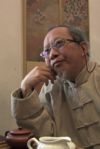
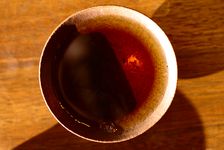
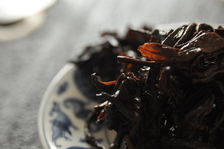

- 1.Ip Wing-Chi
- 2.Frosted aged puerh
- 3.Tea leaves aged in Hong Kong (Copyright Sébastien M.)
- 4.Hong Kong in the mist today
When you have a piece of bread on the table, you can see and feel. After a week or two, molds arrive. And the smell changes and you can feel it. For puerh (Pu Er tea) is the same, but it was not really detailed studies about this process.
For me, I just think that store the tea in a clean, natural environment, in the south of China (Hong Kong and Guangzhou, for example) is a good thing. Because in southern China were seasonal changes in the summer is hot and humid, and in winter it is cold and dry, so you have a cycle and it is very good for the growth of bacteria.
Of course bacteria change with time. There 100 years it was very different from today. Because now we have the pollution, the vegetation is different, the environment has changed. So the bacteria are very different from those of the past. Because it changes very quickly, it's like the flu, every 10 years or something like that you have a new generation, I think it is the same for tea.
But history has shown that southern China is a good environment for the maturation of puerh. I think that the best Yunnan, better than Tibet, Mongolia or I do not know. Of course I think there must be a way (more) perfect (to store puerh) but in the past this has been found very accidental. The puerh (Pu Er tea) tea is gross, very gross. If you look at the Tibetan tea for example, it's so gross, even it there's different kinds of leaves other than in tea. There are for example used in bushes to fire or things like that. He just cut the whole bush, and then reduce it into small pieces and ferment all with tea, etc ...
I personally think it's good to just store puerh (Pu Er tea) naturally in Hong Kong, in a clean and clear. It there's an old saying in Hong Kong said that if you close the door it is a wet storage, if you open the door it is a dry storage, because the air can circulate. So from time to time people are turning stacks of pancakes, they are top down, they go up and down. Because if you have a house in the western district, home is against the mountain, it is very humid, so the door is opened, the air enters and it becomes dry. From time to time we must open the door, change the position of teas in the room, things like that.
But the tea should be in a fairly humid. In the past you can imagine, there was that of the earth. When I went in Yunnan for the first time in Pu'er, there was no brick house, just bricks made of earth. He could not afford to build with stone or clay brick. They simply dry earth and make bricks. So you can imagine in the past, all the houses were like that, and they did not have a concrete floor, the floor was just dirt or wood, sometimes bamboo, with some mats on it, then they stored tea . It must have been very wet with rain, etc. ... Guangdong in particular where a lot of moisture, and can be dry in winter. So I never believed in dry storage, put the tea in a place conditioning, the spoil.
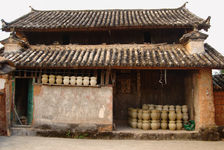
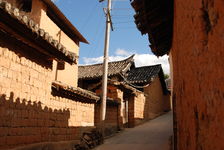
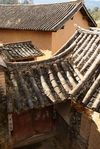
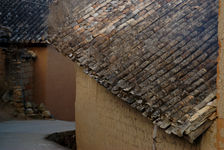
- 1.house land in Yunnan (Lincang)
- 2.Houses land in Yunnan (Lincang)
- 3.House in Yunnan ()
- 4.House in Yunnan (Lincang)
Today things are moving too speeds. In the past when you had to carry puerh, he traveled a very long way. I wrote an article about it:before the tea arrived in Hong Kong, he had already undergone 4 or 5 successive fermentations, so it is already a puerh (Pu Er tea) brown. At that time there was no plastic bag. Now they send the tea in a plastic bag in the truck. And only a few days after the tea arrives at the factory. In time the tea should be stored one year, until the dry season, before being transported:the tea was harvested in the spring, then summer comes, with lots of rain and high humidity. And only then we enter the dry season in winter. And then they carried the tea for a long time under the sun, rain, etc., before it arrives at the factory in Pu'er. There he obtained a license and also left the tea, the famous Cha Ma Gu Dao, the tea road and horses. It took years, all within the context of past and without plastic bags.
So how could he have the cha sheng puerh (Pu Er tea) or green? It is impossible. This is a classic contradiction, people think green tea is tea the oldest. In reality it is very difficult to keep the green tea. Green tea is a very recent invention. In the past, maybe white tea, yellow tea perhaps, perhaps puerh:teas more or less brown. Because when you want to keep the color green, even today it is very difficult. When you for example to dehydration dry food, it is a very difficult process. Take an apple, if you cut the oxidation begins and it becomes dark in half an hour. So you can weigh the difficulty of keeping the yellow color of the apple, or green (tea). This is something really difficult, it adds a lot of things today to keep the color fresh with a simple apple, antioxidant, etc!
For me it is impossible that in the past there was the green puerh, puerh (Pu Er tea) were all fermented.
Of course! The red marks are all fermented puerh, or teas from damp storage, Hong Kong. So what Taiwanese who wrote this book, Mr. Deng has just acted as a reporter, he does not know the reality. He came to Hong Kong, he just looked wet storage and exclaimed "oh it's too dirty." Then he looked at the red marks "Oh this tea is wonderful too."
But in reality it comes from the same place. Before putting the tea on the shelf, we put it in storage (wet), the same. So he made a very bad mistake, then he has continued his instructions to people in Yunnan, it is very stupid. In fact there was no Sheng Cha (green puerh) in history.
Yes. Of course, there are quite a few specifications, can not be too wet, but how? How to say what is too wet? Or not too dry ... but how? it mean anything too dry? So we will keep 40% for example, moisture 80%, etc ... but in the end we do not know, because we need a lot of studying the phenomenon to know (and what has not been done).
People say stupid things just, you know, they guess but they do not have the experience. In Hong Kong there are some experts who tell of things, and in China there too, but they just hunches. If you want to know accurately, you must study the thing, experience.
So we just started a very interesting project for this, we want to make 20 biscuits, cakes or 40 then sends them in places all around the world. Then every year we take a cake, and we meet the tastes together.
Yes yes it is just getting started. Of course this is something you must highly restrictive measure humidity and temperature every day. The minimum, maximum, etc. ... to compare.
For me I think there must have perfect conditions (storage of puerh), which remain unknown, and I do not think anyone know them, because I do not think this kind of experimentation was made.
Exactly. Maybe France is the best place to store puerh. We do not know, because we never tried. Maybe Amazon is the best place, I do not know. Because one has different bacteria in the air, at different temperatures, etc.. So it's really different. So who knows? We need to have a detailed study.
For the time history tells us that only in the region of Guangdong, it was successful because it was still different puerh (Pu Er tea) 50 years, 100 years, stored in Hong Kong so we know what it gave and you can still have the chance to taste them. So it turns out that Hong Kong is not a bad place to store puerh (Pu Er tea) ... but I do not think it's perfect.
If you find a place, or a way to store puerh, or hardware, you may be able to make a tea in 10 years will be similar to a tea 50 years ago. It's beautiful. You have a machine, you put the tea in, and you come out of the old tea (laughs) ... Just building the machine you fortune.
I think it is possible, for wine was modern wine cellars, you can adjust the temperature, humidity, etc.. They sell it or 8000 6000 HKD HKD for 60 bottles or something like that. Why not a machine to be aged puerh? You just set the temperature and humidity, it's easy.
But this lack of study, we need to find the perfect formula, only after we can make a machine puerh. Of course I'm too old to do that. We need to study this year ... but if you find you can make a fortune.
I think a technical point of view it is very simple. Science and technology are now so sophisticated, the only thing that is difficult is that we do not know the exact mechanism (maturation of puerh).
Today in Yunnan there is for example interested in Jing Hua, the golden flowers. Jing Hua is a genus of bacteria, and they do everything what a phenomenon like it would be a medical miracle. I'm curious about it. I do not know how this could puerh (Pu Er tea) associated with the act on the taste, aroma.
But for me, since I started the tea I've tried to be more rational. I still believe that when it comes to science, there must be a scientific approach. When we talk about art you must have an artistic approach. But now people mix the two, when they describe something artistic, sensitive, etc., they take scientific positions. And when they speak they use science to know design. It makes things very confusing.
So I said ok, why not, Jing Hua may be good because it is a form of bacteria, and it reminds aged tea. But I do not know what it can give (with tea). There are those who are convinced and assert that it will give a very good taste, a very good cha qi, etc ... but without explanation. We need explanations. For example what is the income generated by the fermentation? Amino Acids? Polyphenols? Must be able to explain.
It's like about the cha qi , what cha qi ? People, "Ahhh I feel a power here or there, ooooh this is a very good tea." And it is because this tea was grown in this region and this region is very rich in minerals, blah. I ask. Ok so it is very rich in minerals, tell me what minerals are in it? what percentage, and the difference compared to other regions? And how minerals can be related cha qi ? And what cha qi ?
You can not mix things like that. So now this is a problem in the study of Chinese tea, or the tea culture. When they talk about science they use aesthetic terms. When talking about art they use scientific terms. It is a question of terminology. There is a lack of logical explanations, logical basis. So I think if you want to find out which is the perfect way to store puerh, you need to be very scientific, because it is science.
What kind of bacteria you have induce or add the tea? And if you can find the best bacterium can add it when making the cake, the inside of the cake and the tea will become easier mature or something like that. Yes of course the temperature, humidity, cycles etc., one must study, you can not just say "I am an expert in tea I know it must be so and so," I think it is fair to rubbish.
If we talk about science, we must give specifications, something quantitative. After that I talk about my feelings, I can say:ok this is a very good tea, it is like it like that. It's not like it's a different approach.
I am very happy (laughs), because I have made a small fortune as well (laughs). But if I say something, I think as I said earlier, we must take into consideration the culture and tradition of puerh (Pu Er tea) consumption in Hong Kong. A Hong Kong has never drank sheng cha, green puerh, because it is too aggressive for our stomachs, if you drink it long term is not good for the stomach.
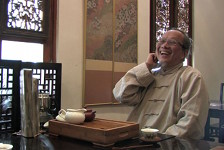
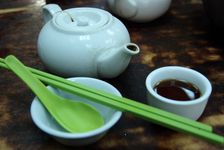
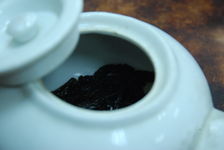
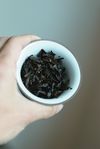
- 2.Frosted dark puerh (Pu Er tea) in a Dim Sum in Hong Kong
- 3.puerh leaves in a dark Dim Sum in Hong Kong
- 4.dark Puerh
So the Hong Kong people still drink puerh (Pu Er tea) brown, whether artificially or naturally fermented puerh. For us it is the same because in the background you can not tell if it is natural or artificial. A Hong Kong tea is stored in wet areas, such as western district, we put the puerh (Pu Er tea) there and then the spell, then returned, then take them out, we have a special way of storing puerh. So finally you can no longer say whether it is natural or artificial ... but what matters is that you should drink puerh (Pu Er tea) brown, not green.
So that's the key, it's really important that I hope people can understand that.
Fermentation artificial puerh (Pu Er tea) has been invented in Hong Kong in the 60s. Because that at that time, with the Cultural Revolution in China, it became really serious, there was more tea that came to Hong Kong! But Hong Kong restaurants could not survive without tea puerh. So they had to buy puerh (Pu Er tea) green somewhere else, Vietnam, and Thailand, and Indonesia, because tea there is practically free. But this tea "green" these countries is very bitter and very astringent, so you can not sell it, and before you turn.
While at first they put the tea in humid, of course it is not as simple as there were many many other stories in, but to keep it simple we noticed that after a few weeks, but soon all the same, tea has changed color. This is very different from natural storage. The natural storage is in a moderately humid, so the tea absorbs moisture, and it takes time.
And then how to get more moisture? By adding water, closing doors, and heating, and very quickly becomes the puerh (Pu Er tea) black. At this time there y'avait a rumor is just dyed brown leaves with ink! This story comes from Taiwan, but in reality it is impossible. People just saw go green leaves (in our storage) and brown highlights, so they thought they were dyed.
Finally it is by accident that Hong Kongers have invented this method, and have provided the restaurant puerh. Then in the 70 export company in Guangdong came to Hong Kong to learn this. A Hong Kong people are lazy, they want to do the hard work, so they have learned to do this in Cantonese:Ok you do that Guangdong has, it's cheaper, then you can sell me after tea.
And then it is the people who went to Yunnan to Guangdong and learned Cantonese. So first it was Hong Kong and Guangdong, and Yunnan. Because the only reason is that only it (the brown puerh) is puerh, puerh (Pu Er tea) the green is not puerh (Pu Er tea) tea, it's just a raw material. It should be a green tea, a oolong, white tea, something else, but not hei cha (tea dark) or puerh. So that's the spirit of our puerh (Pu Er tea) Hong Kongers.
Hong Kong has the old tea because Hong Kong is the only place where we drank puerh (Pu Er tea) in years 50, 60 or 70. At that time China was a planned economy (communist). Guangdong Even you could not choose your tea. If the government could not sell this or that tea export, it was destined for the domestic market. So in general we drank in China green tea and black tea, because it could not sell (export) a lot of black tea at that time, with competition from India, etc..
So we could not drink any puerh (Pu Er tea) in China, and they have lost this tradition. And then the green puerh (Pu Er tea) is because Taiwan is a country of Wulong, a country of green tea. Hong Kong and therefore is ultimately the only place of origin of the old tea, because Hong Kong restaurants all had a lot of tea in their old stocks. Especially after the Cultural Revolution, they did not suddenly be over stock and no longer able to do business. So after 1960 restaurants have stored a lot of tea.
In the 90s, but in fact it started in the 80s before the Taiwanese and speculating that prices rise, many people have started collecting old puerh. It started from Taiwan. Taiwanese are really strong they saw that could do business and speculate on a lot of things, teas, but also boxes while they are able to make a fortune for anything.
Yes yes yes yes, Hong Kong people are very stupid, they just drank tea and sold. At that time we did not made it because we had a lot of tea, and then there are Taiwanese who saw it and who benefited from it. It is very natural that eventually what happened after the 2000s the Chinese began to become rich, they had too much money, so they needed to spend ... and prices rose. So first is Taiwan, then there was the Koreans and the Chinese.
And so yes the price has not stopped skyrocket. In reality it is not related to puerh, if you look at Chinese painting, Chinese antiques, prices are crazy, it's not something directly related to puerh (Pu Er tea) is very natural, just because old puerh (Pu Er tea) stocks are limited. Especially 50 years ago, no one knew how many people would drink in 50 years, so at this time the production was very limited. And these teas were consumed over time. So after 2000, the demand and supply for teas 50s is more balanced.
There is also another very important thing in China, it is the culture of gift. They used puerh (Pu Er tea) as a form of gift, especially if it was expensive. More tea is rare, it is more expensive and more expensive it will become, and conversely the common tea will become increasingly common.
So there is something really stupid, now becomes brown puerh (Pu Er tea) cheaper than green puerh. It's crazy because the brown puerh (Pu Er tea) requires more work, you must do so, as it takes time, space. How this tea can be cheaper than green? It is impossible, this is not normal. Even today it is not normal.
It's just a matter of supply and demand. And in fact the puerh (Pu Er tea) is too cheap. Even today the puerh (Pu Er tea) is too cheap when you compare for example with oolong or black tea, or something like Bi Luo Chun or Long Jing. Recently they made a new black tea, something that costs more than 20000 HKD to 500g ... this is crazy! When you compare with the puerh (Pu Er tea) you find that even Banzhang, or puerh (Pu Er tea) like that really are not that expensive.
Of course you can say that black tea is much higher because of labor is that bud, etc., and the puerh (Pu Er tea) tea is very crude, etc.. But for me the puerh (Pu Er tea) tea is very cheap. Because puerh (Pu Er tea) was nothing before it starts just started. And besides Lao Banzhang, other puerh (Pu Er tea) only cost a hundred HKD for one kilogram is really low.
In the late 80s or early 90s when I went to Yunnan, farmers cut down trees (tea), and planted corn, and sugar cane. Simply because at that time a sugar factory was built, and so they lent money to farmers:Ok you plant sugar cane, I give you money, when you're after cane sugar you will do me the money and I'll buy your production, something like that, So farmers have simply burned the mountain and cut the old trees, and they stupidly planted corn and sugar cane. Because they had nothing to do (tea).
This is why I think the puerh (Pu Er tea) is too cheap. If you give enough peasants, farmers will cut trees. Because everyone wants to make money, especially in China today. Farmers are actually quite humble, but they need money. I think if you can pay more and farmers live comfortably, they will take care of trees, and they will make the tea better.
Except the old tea, puerh (Pu Er tea) is cheap. But the old tea is like antiquity, it is another market, it is not the tea market. You can say that it is a antique market, a market of "gift", a market investment, but it is another thing that tea market. And in this market, there is too much money, people have too much money to spend, yes.
No. In Hong Kong not. I tell you frankly about Brands Red , there is a time I finished a Brand Red in one or two weeks. And now I have not touched for 10 years! Because (laughs) when I take one, I look ... and I said:Oh! it is nevertheless 100000 HKD, it is better to put her in her place, and drink another tea (laughs).
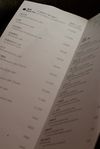
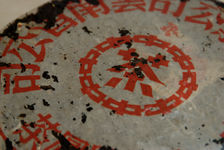
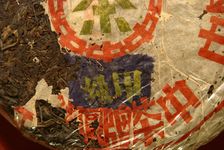
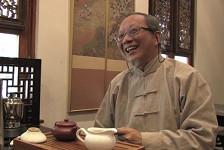
- 1.Map of Lock Cha Tea House
- 2.Red mark owned by Wing-Chi Ip
- 3.Blue Brand owned by Wing-Chi Ip
- 4.Wing-Chi Ip
Even I want to drink more, because it's too expensive for me. Except one day really special, or a special event, if I prefer to sell rather than drink. It is too expensive! Frankly, I am not so rich. I have not opened a Brand Red 10 years is too much for me.
In Chinese art the art of the tea house ...
Yes, I think so. Someone told me once that everyone in life think that a purse and coins. But what you really need is a line from one end of the wire to put together, and it is here that there's (Lock Cha Tea House). So I'm very happy to have found this thread, have this framework and be able to put my painting, my art, my philosophy, my career, my work, everything together. Today everyone has a lot of opportunities, many parts and scholarships, but in general they lack a piece of string. So if you find that piece of string you're lucky. I think I have something to be happy to spend my life in tea, teapots, philosophy, art ... it has beautified my life!
In fact at the beginning I did open a small retail store. This tea house was opened 7 years ago in 2003. But of course I love the tea houses, in 1995 I had already opened a tea house in Suzhou, China. And then when I opened it to Hong Kong (Lock Cha Tea House) I closed the Suzhou. So at first I had a tea shop here. A tea house is a form of ... something like a scene. Something you results performed on stage. So this is something very good power itself:something in mind to send a message to people who come. This is why I love tea houses.
Before the tea house, I was already receptions another tea shop on the first floor is organized concerts of music (traditional). The concert program began in 2001 and so we will celebrate our 10th anniversary this year. It has now been quite a cultural program that I designed for my tea house on Sunday there is live music on the first Friday of the month where we hold discussions are invited well-known personalities.
So I try to see a tea house as a sort of place of cultural exchange. If people like it, they drink tea and then they release the spirit. I think that culture is not something you need to teach or promote, as an exhibition of tea, for example, that's always business, or school or anything like that. I think in a tea house you are comfortably seated and you enjoy the moment. We all have different things in mind about tea, but this tea house can accommodate all the people come just to enjoy the tea.
Course through the design, through service, through the tea, you send messages to people, you allow them to enjoy, feel. I think it is very important to create a tea house.
About the teahouse, I think China or anywhere on Earth, there are people who take it too seriously, others who take an overly commercial, none of them n has reason. So I thought I could keep a balance, which is why I gave my company name Lock Cha (乐, Lock, means happiness, fortune or take pleasure ndrl).
Because at that time, in 1991, was a very enthusiastic and active in the promotion of tea culture. I think it was too arrogant. Especially with my background, I studied Chinese philosophy and the history of China, China has a long history. So we wonder:But what are you doing? Just drink a cup of tea and then you discuss art, culture, that it was 5000 years ago and blah, it's not too much. So I'm just saying, ok benefits of tea, takes pleasure (乐).
So what is the meaning of my company name. The meaning behind it is that I do not do too much about the culture. Of course it is not just because I want to do things in a more significant, but more to do with a different meaning, something poetic, with a deeper meaning, and different layers. But I do not want to educate people, propaganda or something like that.
You just simply, and you take pleasure. I actually really like the poems. Here's one:
| 好 雨 知 时节. | The good rain knows its time, |
| 当 春 乃 发生. | Arrive at the time of spring. |
| 随风 潜入 夜. | Next it winds into the night in secret |
| 润物细无声. | it moistens everything with docility. |
This is my vision, my mind about the creation of this tea house.
You can not escape! Tea is a cultural product, it is more than a drink. But it is very difficult to define what culture is. Because if you want to define a culture, she is already dead, like something in a museum. I think culture is something in the way of life or way of thinking and therefore it is omnipresent in your life, what you do, what you think it is a culture. But if you try to define it as a phenomenon, it is already past.
So we do not know what culture today, but we saw it. Of course for every type of life you have different directions, different levels, and I'm just trying to live my way. If you find there is something in this way is a little resonate with you, then you may be able to appreciate my mind. If you are not in resonance you do not perceive. It's like a radio, if you turn the knob on the right frequency you know what I mean, if you turn on another frequency, you will have something else, and maybe it will not be connected together .
I think it is a form of Yuan , you have come to the teahouse, you met me, you know my style or the way I see things, and everything is sound meaning, you feel the sense that there's back and after we connected, then we can know.
So it is a cultural product, a cultural thing, yes. But if you can not catch the meaning behind it is just a box of tea, just drink. But it's not, no. I think I thought that I could do more than that. In some articles I've written in the past, I have always said the tea like a mirror:it reflects your personality reflects your mind and your thinking.
In the history of Japanese tea will have one when something Sen Rikyu and Hideyoshi make tea. Hideyoshi is a very famous and powerful samurai, he conquered all of Japan and so he built a house for tea ĺ'empereur whole, where everything was made of gold. Sen Rikyu and then made another tea ceremony for the court. He takes the emperor in a very simple, with just three tatami, and serves the tea bowl. Tea is the same, but the meaning is different. And this is not the meaning of tea, this is the meaning of Sen Rikyu and Hideyoshi. So I think anyone, when he made a cup of tea, says something.
I like tea in a very simple, very comfortable, but good tea. I do not want to perform like this (mimics a formal tea ceremony), I like it.
Exactly. Just a teahouse is a creation, it is your work of art. Last Saturday we had a concert here and I just answered this question. After the concert I was talking with a musician, and he noticed that there was always a small detail again here. I am not like other people doing the decoration, then that leaves only, and work just for business. I always change a little something every month or every two months. Because I do not think that here is a place of business. People just invest money, hire a designer, and it's over. They are just business, and any decoration is there to serve the business. Nothing more.
But for me this tea house is a part of my life, so it's just like when you make a painting, sometimes you want to change something here, sometimes you want to add something here, because for me a home Tea is always a creation. Of course I also want to keep my tea house as a place where I live, a place that I like, a place of exchange with other people, not just a trade. So fortunately for that I studied art, aesthetics, so I do not need to hire someone else for decoration.
And I also love tea houses (smile) because I like to go here or there, spend money to get something like this or like that that I bring in my tea house to decorate ... and sometimes I sell this item eventually (laughs), so I'm also money. So I think this is a very good thing, and I always put new elements in it.
It's a hobby, it is decoration, and it may also be business, this is something very pleasant, and you can share with people. Going somewhere in a search for something, then eventually you will find it and you put it right here ... then someone perceives appreciate it, it makes you very happy. This is why I love tea houses.

